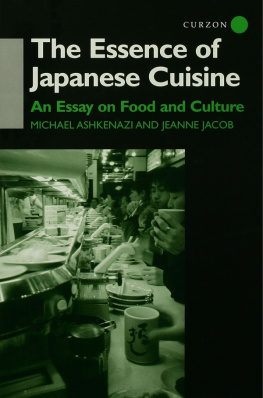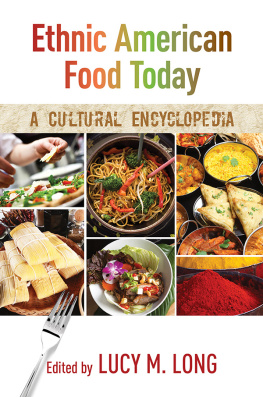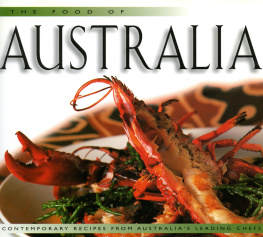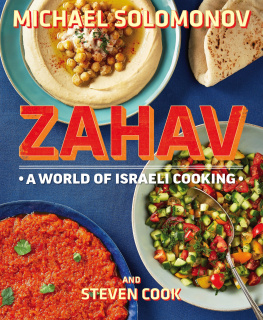Recent Title in
The Global Kitchen
Food Cultures of the United States: Recipes, Customs, and Issues
Bruce Kraig
FOOD CULTURES OF ISRAEL
Recipes, Customs, and Issues
Michael Ashkenazi
The Global Kitchen

Copyright 2021 by ABC-CLIO, LLC
All rights reserved. No part of this publication may be reproduced, stored in a retrieval system, or transmitted, in any form or by any means, electronic, mechanical, photocopying, recording, or otherwise, except for the inclusion of brief quotations in a review, without prior permission in writing from the publisher.
Library of Congress Cataloging-in-Publication Data
Names: Ashkenazi, Michael, author.
Title: Food cultures of Israel : recipes, customs, and issues / Michael Ashkenazi.
Description: First Edition. | Santa Barbara : Greenwood, 2021. | Series: The Global Kitchen | Includes bibliographical references and index.
Identifiers: LCCN 2020007976 (print) | LCCN 2020007977 (ebook) | ISBN 9781440866852 (Hardback) | ISBN 9781440866869 (eBook)
Subjects: LCSH: Cooking, Israeli. | IsraelSocial life and customs.
Classification: LCC TX724 .A835 2021 (print) | LCC TX724 (ebook) | DDC 641.595694dc23
LC record available at https://lccn.loc.gov/2020007976
LC ebook record available at https://lccn.loc.gov/2020007977
ISBN: 978-1-4408-6685-2 (print)
978-1-4408-6686-9 (ebook)
252423222112345
This book is also available as an eBook.
Greenwood
An Imprint of ABC-CLIO, LLC
ABC-CLIO, LLC
147 Castilian Drive
Santa Barbara, California 93117
www.abc-clio.com
This book is printed on acid-free paper 
Manufactured in the United States of America
The publisher has done its best to make sure the instructions and/or recipes in this book are correct. However, users should apply judgment and experience when preparing recipes, especially parents and teachers working with young people. The publisher accepts no responsibility for the outcome of any recipe included in this volume and assumes no liability for, and is released by readers from, any injury or damage resulting from the strict adherence to, or deviation from, the directions and/or recipes herein. The publisher is not responsible for any readers specific health or allergy needs that may require medical supervision, nor for any adverse reactions to the recipes contained in this book. All yields are approximations.
Contents
Series Foreword
Imagine a typical American breakfast: bacon, eggs, toast, and home fries from the local diner. Or maybe a protein-packed smoothie, sipped on the go to class or work. In some countries in Europe, breakfast might just be a small cookie and a strong coffee, if anything at all. A South African breakfast might consist of a bowl of corn porridge with milk. In Japan, breakfast might look more like dinner, complete with rice, vegetables, and fish. What we eat varies from country to country, and even region to region. The Global Kitchen series explores the cuisines of different cultures around the world, from the history of food and food staples to main dishes and contemporary issues. Teeming with recipes to try at home, these volumes will delight readers by discovering other cultures through the lens of a treasured topic: food.
Each volume focuses on the culinary heritage of one country or one small group of countries, covering history and contemporary culture. Volumes begin with a chronology of major food-related milestones and events in the area, from prehistory to present. Chapters explore the key foods and meals in the country, covering the following topics:
- Food History;
- Influential Ingredients;
- Appetizers and Side Dishes;
- Main Dishes;
- Desserts;
- Beverages;
- Holidays and Special Occasions;
- Street Food and Snacks;
- Dining Out; and
- Food Issues and Dietary Concerns.
Chapters are textual, and each chapter is accompanied by numerous recipes, adding a hands-on component to the series. Sidebars, a glossary of important terms, and a selected bibliography round out each volume, providing readers with additional information and resources for their personal and scholarly research needs.
Whether readers are looking for recipes to use for classes or at home, or to explore the histories and traditions of world cuisines, the Global Kitchen series will allow readers to fully immerse themselves in other cultures, giving a taste of typical daily life and tradition.
Preface
I would like to use the term Israeli diet to describe the foods that Israelis eat, while reserving the term Israeli food or Israeli cuisine to describe foods that relate to an image of the nation and national culinary landscape.
Bernard-Herman, 2014
This book is about both of Bernard-Hermans terms, something I shall call throughout Israeli food culture. About three-quarters of the text of this book is devoted to describing what Israelis eat, whether in the form of a pictured description, or of recipes that the reader can follow at their leisure. The remaining quarter, interwoven within the descriptive element, is an attempt to answer the question of how Israelis eat. I am less concerned here with the issue of meaning, although that emerges from the analytical part as well.
I think it is useful also to note what this book is not. This is not a cookbook (there are plenty of excellent Israeli cookbooks, many referenced in the Bibliography). This is also not an academic treatment of Israeli food culture. Rather, this book intertwines some analytical comments with a great deal of observational data about Israeli food, how to make it, and how to consume it as Israelis do.
Pronunciation Guide
Hebrew and Arabic are both difficult to pronounce for nonspeakers. Since the two languages are similar, most remarks here are true for both, except that the pronunciation of Arabic is more guttural. Most of the comments here refer to Hebrew, but unless noted, can be taken for Arabic as well. The orthography of Hebrew and Jewish words is contentious and confusing. I have tried to be consistent, but often a common word goes against this practice, whereupon I have followed the more widespread convention. Thus, Hanukkah rather than the more proper Khanukkah.
- There are two glottal stops: a soft alef/alif, similar to the starting vowels a, i, u, e, o in English; and a throaty stop ayin/ayin pronounced somewhat like a choke in the back of ones throat, a, i, u, e, o. The ayin is represented here by , for example, amba.
- r is rolled and throaty, rolled from the back of the palate.
- A kh sounda hard h(written here kh or ch, since the common orthography is inconsistent. The English ch as in cheek does not exist) is a throaty scraping like the ch in German.
- The accent is almost invariably on the ultimate or penultimate syllable.
- In Hebrew, plurals are generally formed by the suffix im for male nouns and ot for female. Thus, kibbutz (singular, male) and kibbutzim (plural, male), but moshava (singular, female) and moshavot (plural, female).
Israeli and Palestinian
Just to preempt argument. The term Palestinian for Arab residents of the West Bank, Gaza, and refugees who left the area of Israel emerged only in the 1960s. Previous to the establishment of the State of Israel, Israeli Jews called themselves Palestinians. For sake of clarity, in this book, Israelis refers to all Israelis: Jewish and Arab citizens of Israel. Israeli Jews is obvious. Israeli Arabs and Arab Israelis refers to those Arabs who are Israeli citizens, most being descendants of those who did not flee (or were ejected, depending on version of story) during the War of Independence (19481949). Palestinians refers to Arab residents of the West Bank and the Gaza Strip who do not have Israeli citizenship and aspire to their own state. This book is about Israeli food culture, which includes many foods and practices common to Israelis and to Palestinians. Palestinians and Arab Israelis have similar, but different, food cultures for sociological and historical reasons. One hopes that a similar book on Palestinian food culture will be published in the future.
Next page









